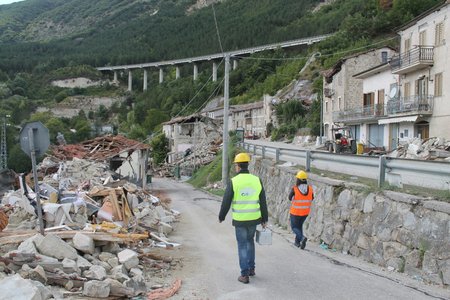Seismic Microzonation (SM) is a key tool for planning strategies for risk mitigation; it represents the assessment of Local Seismic Hazard by identifying and mapping, at scale 1:10.000 or higher, zones with homogeneous seismic behavior within a given geographic area. SM studies are complementary to the Regional Seismic Hazard (RSH) studies, which calculate with probabilistic and deterministic methods ground motion parameters at a site under conditions of rigid and flat soil (NTC 08). In 2008, the Conference of Regions and Autonomous Provinces of Italy and the Civil Protection Department published "Indirizzi e criteri per la Microzonazione Sismica" (“Guidelines for Seismic Microzonation”, 2015).
The “Guidelines for Seismic Microzonation” is a national reference document for studies to estimate the seismic risk of a territory. The document describe the principles and elements for basic studies and for applications in land and emergency planning. This document also describes operational tools for the implementation of Seismic Microzonation studies, including the schedule investigations and the production of thematic maps.
The seismic microzonation (SM) identify zones with homogeneous seismic behavior. The identified microzones are classified basing on the expected local ground motion in case of earthquake, and are subdivided into:
- stable zones, where no substantial deviations are expected from the ground motion produced by a seismic event on rigid and flat soils;
- stable zones prone to local amplification, where ground motion is amplified because of local stratigraphic and morphological conditions;
- instability-prone zones, where permanent instabilities, slope instability, liquefaction, differential settlement, active and capable faults, are expected.
Le tipologie di instabilità individuate sono:
- instabilità di versante;
- liquefazioni;
- faglie attive e capaci;
- cedimenti differenziali.
Three levels for SM studies of increasing complexity are determined.
- Level 1: it consists of a collection of existing data that are processed to divide the investigated area into qualitatively homogeneous Microzones. This level of analysis is a preparatory level for the next levels and only in some cases can be considered exhaustive. The result of Level 1 is the Map of Seismically Homogeneous Microzones at scale of 1:5000 – 1:10000.
- Level 2: in this level, insights for the uncertainties identified in the Level 1, are conducted, and quantitative elements associated with the homogeneous zones are introduced. The quantitative elements are amplification factors, calculated with simplified methods (schedules and empirical laws). The result of this Level is the Seismic Microzonation Map at scale of 1:5000 – 1:10000.
- Level 3: it represents the level of maximum detail that should be applied 1) to stable zones prone to local amplification (under complex geological and geotechnical conditions) when problems cannot be solved using the aforementioned schedules, when a global detailed analysis may be useful, for buildings or structures of particular importance and strategic function, and 2) to zones prone to particularly severe instabilities owing to the complexity of phenomenon and/or to their local widespread character.The results are amplification factors calculated by quantitative numerical methods (response spectra, acceleration) for each stable zones prone to local amplification, and indexes of instability for each instability prone-zones. The product of this Level is the Detailed Seismic Microzonation Map covering particular issues or areas at suggested higher scale ( ≥ 1:5000).



